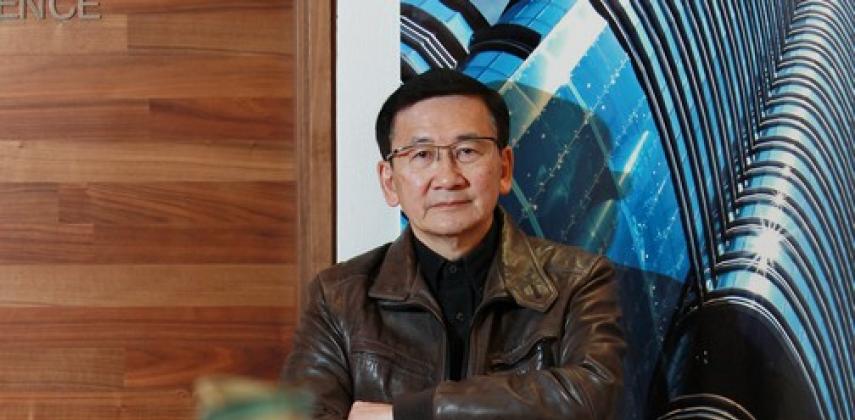From his high-rise office in the heart of Causeway Bay, Dennis Lau Wing-kwong has a bird's-eye view of many buildings his firm has designed over the past three decades. The panorama takes in local landmarks such as Lee Theatre Plaza in Causeway Bay, K11 in Tsim Sha Tsui, the Harbourfront in Hung Hom and Central Plaza in Wan Chai, and five-star hotels and apartment blocks towering above Mid-Levels and Happy Valley. It is a changed prospect from his early days with a small local firm, working on tenement buildings and learning on the job from site foremen and engineers after graduating from the University of Hong Kong. Later, as a partner, he pushed for expansion to capitalise on the city's construction boom. And now, as chairman and managing director of the 300-strong Dennis Lau & Ng Chun Man Architects & Engineers (HK), he is overseeing some of the world's most ambitious development projects.
What first interested you in architecture?
I was one of a big family growing up in Hong Kong after the second world war. At the time, many people were poor and buying toys was a luxury. So, I started making toys for myself from paper and old furniture, a habit which trained me to look at things in 3D and create something out of nothing. Later, I was always making models of ships, aeroplanes and houses, but what I especially remember is when my school - St Joseph's College - redeveloped an old European-style building. I found the process fascinating and spent an hour a day visiting the site, looking at the construction plans, scaffolding and foundation work, and determining that's what I wanted to do.
What are the turning points for the firm?
There were three important periods. In the late 1970s, local Chinese developers started to pop up and gave us more opportunities. Up to then, five or six established firms of architects had monopolised the bigger projects. Then, when the [MTR] Island Line started in the '80s, we worked on new development sites like Kornhill and Vicwood Plaza. And when we designed Central Plaza * the fourth highest in the world in the early '90s - we used new techniques with reinforced concrete, which helped us become famous for high-rises.
Which parts of the job can still prove difficult?
These days, I leave project management to the team captains. They can come to me for help or more resources but, overall, they are very experienced and know what I want. That part, and convincing clients, is not so difficult. But convincing government officials to approve a project can be very frustrating * there is so much red tape. I have a reputation for being tough and not giving up that easily if something isn't approved. After 40 years in the business, I am prepared to go to the top. I don't ask for special treatment, just what's reasonable.
What is the firm’s future direction?
Expansion in Hong Kong isn’t easy. With the planning controls and limited land supply, the jobs here are now smaller, slower, and the fees are lower. In contrast, projects in the mainland can be up to 7 million square feet, time scales are shorter, and the authorities generally want to build something distinctive. For example, we are now talking about three super high-rises of between 80 and 110 storeys in Guangzhou, Chongqing and Nanning. We are also getting more work from Eastern Europe, the Middle East, and will soon start looking at India.
Of the buildings you have designed, which are personal favourites?
I've done more than 200 projects, but there is never one I think is perfect. Afterwards, you always see something that could be better if you did it now. Maybe, though, that is what provides the drive for an architect to keep on improving. That said, the Grand Lisboa in Macau was exciting because there were no restrictions on design or budget. And I'm proud that my first complete building - the Chung Chi Hall Student Centre at the Chinese University - is still there.
Have you tried to develop your own distinctive style?
That’s one thing I’ve consciously tried not to do; every building is different. I’m against the idea of an architect making a monument for himself. All I want is that the building should be the best. For me, the most important design element is how to make the people inside like it.
What do you read for relaxation or inspiration?
I like the Chinese classic Story of the Three Kingdoms, describing the warlord period. As a novel, it covers politics, cultural aspects, and dealing with people. Over the years, I’ve read it more than 25 times and, as I’ve got older, it has shown me how to handle different problems at different times. In other ways, I’ve also been very inspired by a book on Deng Xiao Ping which explains how, despite the setbacks, he kept fighting to get to the top. I must have read that one at least 10 times.
What general advice do you give people considering the profession?
Of course, things are changing now. When I was at university, the target was to get a job, design a building, and steadily gain experience. It seems many of today's graduates just want to get their professional licence as quickly as possible, make a lot of money, and buy a flat. They often have very short-sighted targets and unreasonable demands that create pressures for themselves and their employers. They should remember that architecture is a life-long career and not expect everything at once.
Work at home
Lau finds it more effective to stay in Hong Kong instead of always travelling to overseas project sites and offices
He believes the key to good architecture is to plan from inside out, thinking first about the needs of users
His priority at weekends is to visit outlying islands and see his grandchildren


